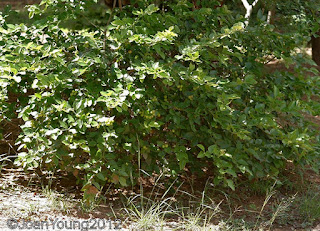Family Apocynaceae
Description Carissa edulis is a much branched spiny evergreen shrub or small tree, usually multistemmed, often scrambling up to 6 m tall and forming a dense canopy. All parts of the plant release white non-toxic milky latex.
This shrub has many traditional uses and forms a good hedge.
Description
Carissa edulis is a much branched spiny evergreen shrub or small tree, usually multistemmed, often scrambling up to 6 m tall and forming a dense canopy. All parts of the plant release white non-toxic milky latex.
The plant is armed with rigid spines up to 70 mm long and nearly always simple, not forked as with other species.
Leaves are simple and opposite, leathery, dark green above and paler below, with or without hair; and leaf base is shallowly lobed; margins are smooth; leaf stalk up to 5 mm long.
Flowers in terminal heads up to 40 mm in diameter, white tinged pink to purple and up to 20 mm long; corolla with lobes overlapping to the right, with a strong sweet jasmine-like scent. Flowering from September to December.
Fruits fleshy, ovoid, 6–11 mm in diameter, red to purplish black berries 2- to 4-seeded. Unripe fruits are green with red to purplish marks. Ripe fruits are dark red to purplish black.
Habitat
It occurs in bushveld, often in riverine vegetation or on termite mounds,and common in deciduous to evergreen woodland; it is partial to granite soil.
Distribution
From Senegal and East Africa in the north to Mpumalanga and Limpopo in the south. Also in Asia to India and Thailand, and on some Indian Ocean islands.
Uses and cultural aspects
Traditionally decoctions of roots are used as pain killer and to treat malaria. Taken warm and in small quantity it is also used for indigestion and for abnormal pains during pregnancy. The fruits help in the treatment of dysentery. The powdered root is used as a remedy for chest complaints. An infusion made from the roots is drunk to ease stomach ache, as a cough remedy or is dropped into the eye for cataract problems. Roots contain carissin that can be used to treat cancer. It has been successful in treating Herpes simplex virus.
Leaves are eaten by kudu, nyala, bushbuck, impala and grey duiker and the fruit eaten by kudu, grey duiker, baboons , monkeys and bush pigs. Fruits are edible, the milky red pulp having a pleasant sweet taste and being much sought after. The fruit can be fermented to make a refreshing pink wine or left longer to make vinegar. Birds favour the tree for nest building, and fruit eating birds (francolins, louries, hornbills, barbets and bulbuls) love the fruits.
If planted close together it can be grown as an effective hedge to keep intruders out and can take heavy pruning quite well. When planted as a hedge along a fence after a period of eight years the hedge will be so thick that no stock or game will be able to penetrate it. A delightful addition to any garden, it does not have an invasive root system and can be planted close to buildings. It makes a successful background plant with its scrambling habit and masses of fragrant whitish flowers. Boys eat the fruit when looking after livestock in the forest. It is also an ideal refuge for small animals and reptiles like snakes.
Info: http://www.plantzafrica.com/frames/plantsfram.htm
Plant identification: Braam van Wyk





